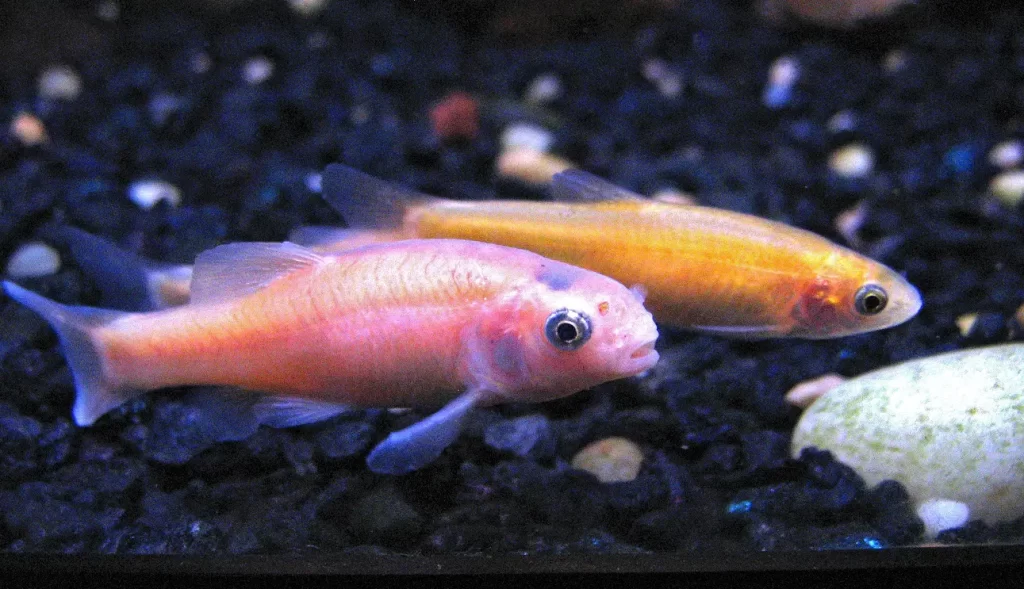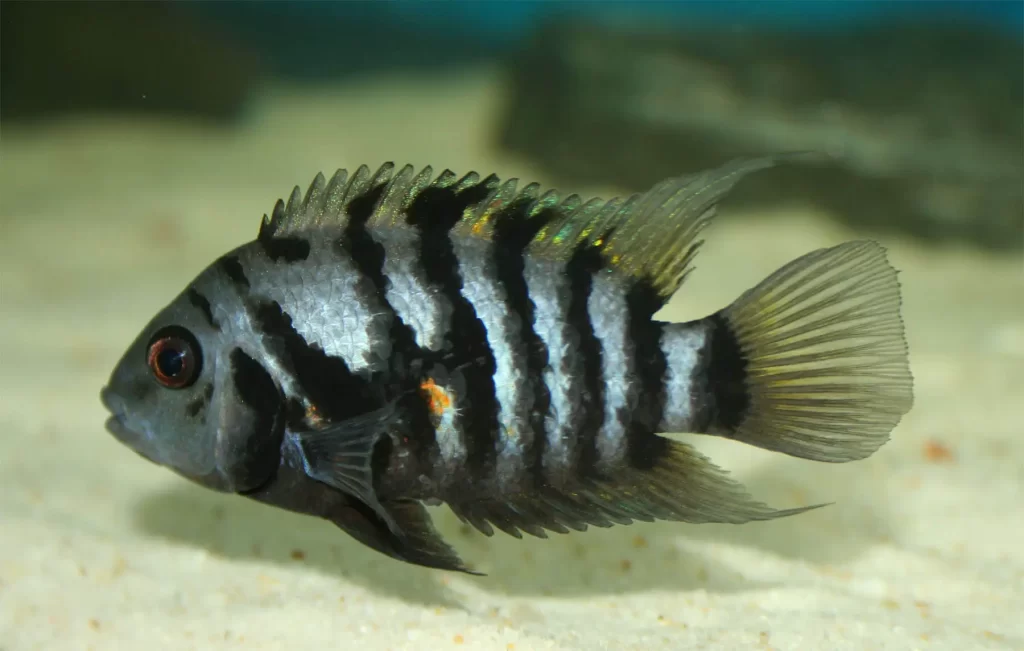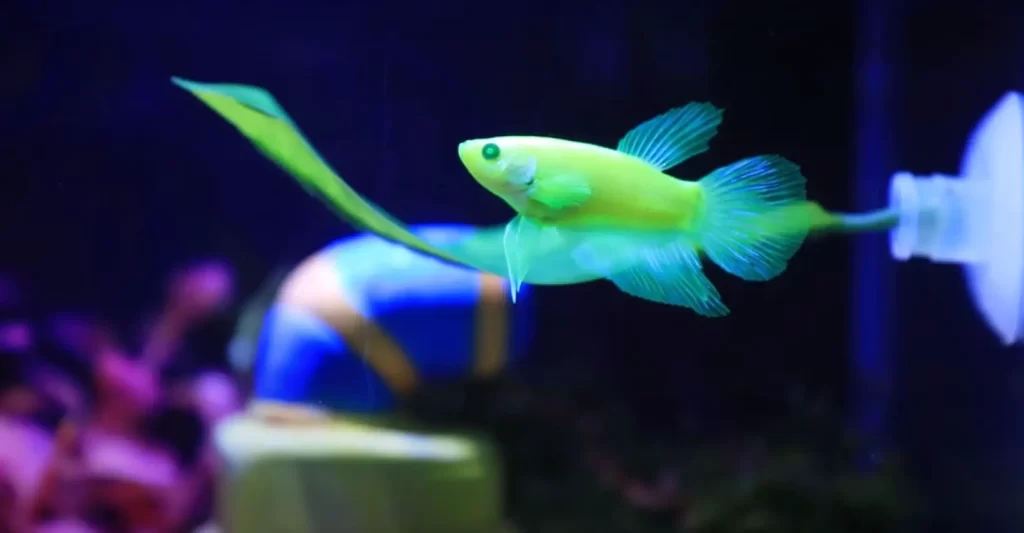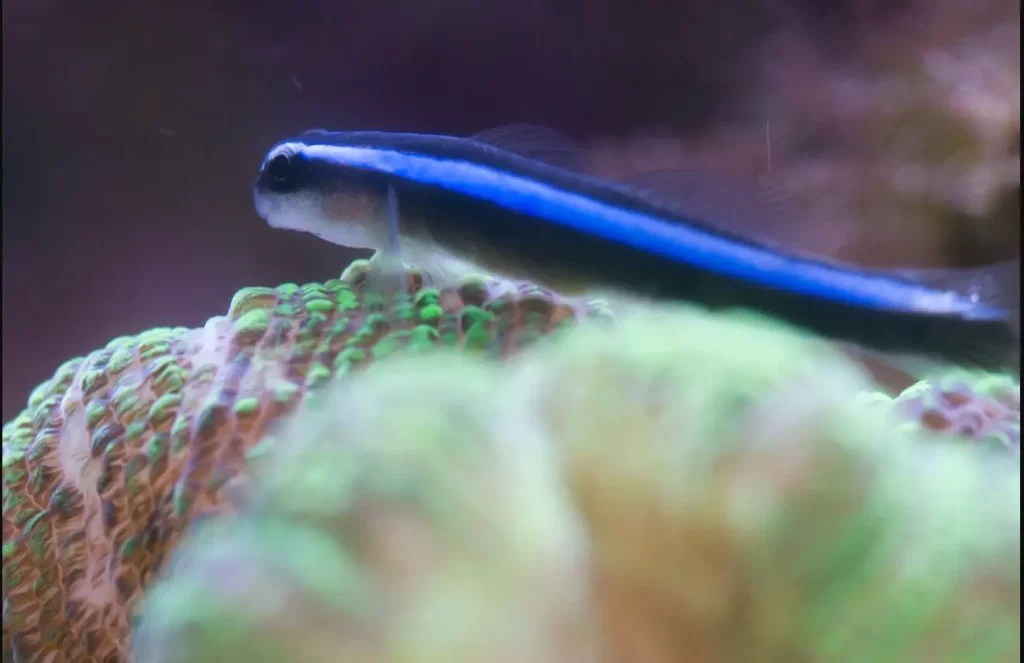People get into fish-keeping for various reasons and up to various extents. Some people have acquired it professionally while some take it as a hobby. Some people want to keep fishes but don’t want to pay proper attention or can’t give much time for regular maintenance. Extremely hardy fishes are ideal for people like these. One such extremely hard fish species are the rosy-red minnows. This fish can tolerate extreme situations and water conditions both in wild and captivity. This is the reason why they are the non-dedicated fishkeeper’s ideal fish.
Rosy-Red Minnows are 2-4 inches in length. They are mostly golden, pink, or orange in color. The origin of Rosy-Red Minnow is from North America, and due to their abundance, they are classified as least concerned (LC) by IUCN. They are hardy fish, so maintaining the water parameter is relatively easier. Breeding Rosy Red Minnows in the aquarium is doable if we provide an essential breeding environment.
In this article, we will be looking at the basic care guide of the rosy red minnows. We will be looking at the breeding diet, water conditions, behavior, etc. All this information will be more than enough to start your fish-keeping experience with the rosy-red minnows.
Introduction To Rosy-Red Minnows
Fathead minnow (Pimephales promelas), also commonly known as rosy-red minnows are popular temperate freshwater fish. Other nicknames like roses, Tuffy, blackhead minnow, feeder fish, ruby red feeder, or baitfish are also quite common among fish-keepers. While most keepers keep them as feeder fish for bigger cichlids, these can be a great addition to your tank.
They are known for producing a chemical signal when under stress or a predator attack. This chemical signal is released in the form of cells, also called Schreckstoff.
Origin And Habit In The Wild
The fish originates across North America from Chihuahua, Mexico, north to the Maritime Provinces, and Great Slave Lake drainage of Canada.
Due to its ability to thrive in any water conditions, it can be found all over the world today. People have also farmed these fish commercially for baiting purposes.
Their natural habitat comprises lakes, ponds, and wetlands with a low concentration of oxygen. Along with low oxygen content, fluctuation in pH, a significant deposit of silt, and improper temperature can also be found in their natural habitat. Sometimes the temperature can even reach about 100F.
These fish can easily survive in the water conditions which other fish find it difficult to live in.
Fish Appearance
The tiny colorful body attracts aquarists in the first place. They can length anywhere between 7 and 10 cm. You can find the fish in mainly three dominant colors: pink, pale orange, and golden. You may also see them in dark colors like grey or brown. These colors are the variant of the fathead minnow. Today most of the rosy red minnows are the result of fathead breeding. The fish has patches of grey and brown coloring. You may also notice a pale stripe from its head to tail.
The body is slender and a bit flat at the head. Their slender body makes them quite a fast swimmer despite having a blunt spout.
Male vs. Female
Sexual dimorphism only exists in the form of size as the male is a bit larger than the female. So, you might have a hard time differentiating the sexes.
The adult male can sometimes grow white breeding tubercles on the snout. You may also notice a large, grey fleshy growth on the nape. However, these features are not the primary basis for differentiating the male and female because these can be a result of poor water conditions and other diseases.
Availability
Because of the abundance in both wild and captivity, IUCN has classified this fish as least concerned (LC), which means that people are freely allowed to breed them and extract them from their wild habitat. Their ability to tolerate extreme conditions like turbid water and low oxygen content is truly remarkable. This explains their abundance quite clearly.
Lifespan
The average lifespan of a rosy-red minnow is 2-4 years. However, various factors can affect this, and they may die early. For example, if the fish is infertile or hasn’t bred in its entire life, it can surely live longer. However, if rosy minnow gets infected by diseases and infections, it may not make it up to a year. So, as a fish-keeper, you have to prevent it from disease and provide necessary treatments.
Price
Since people prefer these fish as feeder fish, you can buy them per pound rather than per piece. One pound, which may have up to 90 fishes, may cost you $15. But this price is not universal, and it may vary from place to place.
In fish stores, however, you can get them as low as a dollar for a pair. This price may not be a fair deal, but this is the difference between wholesale and retail.
General Behavior And Tankmates
Rosy red minnows are schooling fish, meaning they prefer living in a group rather than alone. A group of at least 5-6 fish is recommended. If you keep them alone, they will change their behavior from active swimmers to lousy and somewhat aggressive.
These fish won’t nip the fins of their tank mates. But when you keep them alone with other species, they will ram their head into other fish. You may also notice brief chasing. But when in a group, these fish are active swimmers and won’t care about anything else. They will hover around the tank and mind their own business.
In their tank, you should avoid any fish that will see them as food. Bigger cichlids should be avoided at any cost. You can use these fish as food to feed your predator fishes. When under attack by a bigger fish or predator, these fish excrete a chemical signal that tends to be harmful to the tank.
Similar sized fish with similar temperament would be perfect tankmates. Any cold-water fish like White cloud Minnows, hillstream loaches, dojo loaches, and goldfish would do just fine.
Chemical Alarm Signal
Ostariophysan fishes like rosy red minnows tend to produce a chemical signal. This chemical signal is released in the form of epidermal cells. Other ostariophysan fish can detect this signal and take necessary anti-predator actions like hiding or swimming to a safer spot. When the predator ingests the substance, the predator will label the naïve minnows as dangerous. This chemical alarm system also allows these fishes to be safe in areas with low visibility. This alarm substance is also known as Schreckstoff.
Fish Keeping Difficulty
Probably the only difficulty in keeping these fish is finding a healthy one. Generally, sellers or fish keepers use them as bait. So, they prefer keeping these fish in a small tank with no proper care and maintenance. They are kept in cramped and filthy feeder tanks in most fish stores. These feeder tanks contain lots of harmful parasites. So, introducing infected fish that has spent its whole life among pests can bring a lot of harmful consequences in your aquarium.
Caring For The Fish
Like any other aquarium fish, it needs proper care. Although the fish can adjust in harsh conditions, maintaining the captive environment can bring up the colors and make your tank look more beautiful. You should strictly monitor certain aspects like food and water parameters to ensure that the fish live to its fullest.
Fish Tank
For a group of 5 to 6 minnows, a tank of 10 gallons size is perfectly fine. Although in fish stores, they are kept in a lot smaller space, and they do just fine; but it is not humane to do so. So, I would always suggest you go for a minimum of 10 gallons. For every fish you add, at least 1 gallon of water must be added.
Keeping them in a community tank with fish of similar nature and temperament is always ideal. So, I recommend a larger tank with two or more species in it, including the minnows.
Also, the school must have either an equal number of male and female or the number of females must be higher. Anyhow you must try to reduce the sexual tension and dominance.
Lightings
These fish don’t need intense light in particular. Exposing them to the daylight for 10-12 hours is just enough. If you want to add plants in the tank, you might want to add lights, but other than that, the fish doesn’t demand lights in particular. These fish can live in cloudy water with low visibility. So, they can use their sense of smell to know about food and can also know about threats and predators.
Decoration And Substate
These fish don’t have a specific preference for decorations. You can either add natural plants, caves, or other decorations in the tank. Rocks, driftwood, and caves can all be suitable for a rosy-red minnow tank. You must be sure that these decorations won’t affect the swimming space for the fish. You can add edible plants like algae or flowing duckweed because it contributes a lot to their diet.
The choice of the substrate also doesn’t matter very much. Gravels or sand a work just fine. Because these fish are filter feeders meaning they will eat all the waste food from slits and gravels. You can also choose sand if you want things to be softer and want to grow plants.
Rosy-Red Minnows Diet
Rosies are omnivorous, meaning their diet consist of both plant and animal-related food. These fish are categorized as Benthic filter feeders. This eating habit resembles that of whales, clams, krill, etc. Fish with such eating habits just open their mouth and absorb anything that happens to be there. Later they will filter out any unwanted or inedible parts.
In nature, their animal-related diet comprises of insects, crustaceans, other aquatic invertebrates, and zooplankton. The herbivore portion of their diet consists of algae and phytoplankton. In the aquarium, they will swim to the bottom and eat any debris or remaining food. You can give them flake food and pellets. These foods must be finely crushed and made sure that they fit in their mouth.
It is fair to say that they feed on anything that fits in their mouth.
Maintain Water Quality
Lights, diet, and tanks are not the only thing that you must take care of. Having a suitable water quality also determines the glow and colors that your fish will reflect. If you don’t maintain the water parameters, your fish will eventually turn pale, and there no point in keeping a pale aquarium fish.
Water Temperature
Red rosy minnows are temperate fish, meaning they prefer living in cold water. A water temperature of about 60-78 F is enough for them to thrive. Since most of the aquariums maintain this temperature at room temperature, you don’t have to use a heater with these fish. However, if you have a community tank with tropical fishes, I recommend using a heater. These fish also can tolerate temperature up to 80 F quite easily. This adaptation quality is what makes them so popular among fish-keepers.
pH And Hardness
A wide range of pH suits these fish, but I recommend maintaining a pH of 7-8. If your water becomes too basic or too acidic, then take necessary actions.
These fish can thrive in quite hard water also. Water, rich in dissolved chemicals like magnesium or carbonate, doesn’t affect this creature at all. So, the aquarium water can be mildly soft to hard.
Filtration
The rosy red minnow isn’t a messy fish. It eats the waste food and debris, reducing the waste in your aquarium. But this doesn’t mean that you don’t have to install a filter. A less powerful HOB filter or sponge filter will work just fine. But if you are keeping them in a community tank then, you must consider the overall waste.
You should also choose a filter that doesn’t create a huge water flow. This might have a significant impact on their swimming. My best suggestion would be to install an air-driven sponge filter. But in a community tank, you should always install something more powerful.
Water Maintenance
As a responsible fish-keeper, you should always maintain the water and create a healthy environment for your fish. The basic thumb of rule ifs to perform a 10% water change every week. This helps to remove dissolved unnecessary impurities like nitrate, ammonia, phosphate, and chlorine.
I recommend you to get a complete water test kit. With the help of this kit, you can test the presence of dissolved gases and ions like carbon dioxide, oxygen, phosphates, ammonia, etc. You should also take the necessary actions to reduce the concentration of these impurities. Although these minnows can withstand harsh conditions, it is always better to say o the safe side.
Rosy-Red Minnows Diseases
In fish stores, you can see hundreds of these fish packed in a small tank. This increases their chances of being affected by a fungal infection, bacterial infections, and parasites. There is a high chance that the fish already comes with lots of disinfections when you buy it. This means you could be introducing a lot of threats to your healthy tank while buying them. So, I recommend everyone to inspect the fish closely before purchasing it. It is your right and also a moral duty as a responsible fish-keeper.
If you take good care of them, there are extremely low chances of them getting sick. If they get parasitic infections, you must put them in a quarantine tank and treat them with necessary antibiotics.
Breeding The Rosy-Red Minnows
Rosy red minnows are excellent parents and are easy to breed in captivity. The parents become fertile, mainly in the summer season. A female can lay up to 400 eggs at a time. In a productive season, one female can lay 6,800 to 10,600 eggs. After that, the male has to protect the eggs from predators and diseases.
These fish follow a parental method called alloparental care. During a reproductive season, a male takes over the nest of a nest-guarding male rather than choosing an empty one. This ensures that the nest has a newer, fitter, and better guardian. As the clutch size increases and the new male takes over, the responsibility also increases. Females also prefer to spawn with those males who already have a nest with eggs:- the more, the better.
The male has to remove infected eggs and protect the eggs from predators. The male also prevents the eggs from disease by rubbing the dorsal pad of mucus-secreting cells to aerate the eggs. Because of this, their chemical alarm signal in epidermal cells can reduce to zero.
The eggs will hatch within five days, so the cost of this method is rather small. The juveniles grow quickly, reaching 50mm in 90 days. You can give them hatched brine shrimp or infusoria a few days after they are hatched out.
Conclusion
All in all, rosy red minnows are the perfect choice for beginners or kids. If you want to keep fish but don’t want to dedicate much time to them, get a 10-gallon tank and put some of them in it. These fish can survive harsh conditions, and you can breed them easily. These fish are neither picky eaters nor prone to extreme diseases. So, if you are looking for something extremely hardy, go for them without a second thought.
I think I have included everything related to these cut little fish. Any feedback or doubts are heartily welcomed in the comment section.
Reference
Image Credit:
- https://en.wikipedia.org/wiki/en:public_domain






